PinotFile: 9.33 November 9, 2013
|
Winemaker Ken Brown: Veteran Still On His GameIt seems that in our eagerness to discover the latest new cult producer of Pinot Noir, we often overlook the veterans whose reputation has been firmly established through years of accomplished winemaking. I am talking about icons such as Ken Brown, a pioneering original in Santa Barbara County who continues to craft some of California’s most captivating wines. Byron Kent “Ken” Brown is a third generation California native who was born in Sacramento. Winemaking was not on his radar as he grew up and attended college, opting instead for a career in the burgeoning computer industry at IBM as well as working for his father who was a real estate developer. It was a visit to a Napa Valley winery that drew his attention to wine and he began making wine at home. In 1974, he enrolled in the California State University at Fresno’s viticulture and enology program. His interest in viticulture was noteworthy since most winemakers of the time spent little time in vineyards. This unique but now widely embraced adjunct to winemaking was to prove invaluable in his later success. Ken always considered himself a winegrower, that is, an equal combination of viticulturist and winemaker. After graduation, Ken became the founding winemaker at Zaca Mesa Winery in Los Olivos in 1977 where he designed and equipped the new winery. The original Zaca Mesa property was bought in 1972 by a group of friends who started planting a vineyard in 1973. It was at Zaca Mesa that Ken planted the first Syrah in Santa Barbara County in 1978. In 1984, realizing the potential of Santa Barbara County and in particular the Santa Maria Valley to produce fine Pinot Noir and Chardonnay, Ken left Zaca Mesa and along with partners, founded Byron Winery in the Santa Maria Valley on the site of the original Nielson Vineyard. This vineyard was Santa Barbara’s first commercial vineyard established in 1974 by pioneer Uriel Nielson. The first Byron Pinot Noir was released in 1984 from purchased grapes (Tepusquet Vineyard 1973 plantings and Sierra Madre 1974 plantings). The success of Byron prompted the Robert Mondavi Corporation to invest heavily in the Santa Maria Valley eventually acquiring 600 acres of Santa Maria Valley land that included 175 acres of vineyards. Mondavi bought Tepusquet Vineyard in 1988, the adjacent 118-acre Nielson Vineyard in 1989, and acquired Byron Winery in 1990. Ken Brown’s 20,000-case Byron Winery was producing some of the best Pinot Noir and Chardonnay in the state, but he lacked the capital to grow the winery. Matt Kramer said, (New California Wine, 2004), “Byron Chardonnay has long been, and remains, one of the benchmark bottlings in Santa Maria Valley.” Mondavi’s buyout allowed him to stay on as winemaker and the winery’s production was expanded to more than 50,000 cases. While at Byron, Ken worked with many Santa Barbara County vineyards, but mainly sourced Pinot Noir from Nielson Vineyard, Tepusquet Vineyard and Sanford & Benedict Vineyard. In his time at Byron under Mondavi ownership, Ken directed the construction of a modern, gravity flow winery in 1996, and conducted a number of experimental vineyard programs. He eventually tired of the corporate winery milieu, and left in 2003 to start his own modest eponymous label. Ken Volk purchased the Byron winemaking facility and renamed it Kenneth Volk Vineyards. The Byron label passed through several owners including Constellation Brands, Legacy Estates Group, and Jackson Family Wines who is the current proprietor. Ken downsized considerably, with he and his spouse Deborah producing a modest 2,000-2,500 cases of carefully handcrafted wine under the Ken Brown Wines label. He occupied a shared warehouse facility in Lompoc beginning in 2005, and then moved to Terravant Wine Center in Buellton in 2008 where Ken consults for a number of other larger labels. Ken’s accomplishments are varied and he has left his mark on many current wineries in Santa Barbara County. A partial listing of his achievements include the following:
• Ken was one of the first vintners to realize the potential of Santa Barbara County to produce world-class Pinot
Noir and Chardonnay.
Varietals offered by Ken Brown Wines include Pinot Noir, Syrah, Chardonnay, and Sauvignon Blanc. Since Ken has many long time associations with growers, he has access to desirable select blocks within vineyards. He buys fruit by acreage contracts so his name is attached to certain rows of vines. His sensibly priced wines are offered through retail channels and the website at www.kenbrownwines.com. Wine tasting is available Friday-Sunday from 11:00 to 4:00 or by appointment at the Terravant Wine Center tasting room located at 70 Industrial Way in Buellton (805-688-4482). Despite Ken’s status as a winemaker emeritus, he regularly attends events to pour his wines and patiently points out vineyard source details that he considers highly relevant to understanding his wines. He is modest, unpretentious, informative and beyond reproach as a professional. There is no need to seek out the latest Pinot Noir rave offering overpriced and over hyped wines, for we are blessed to have an easily accessible veteran who is still on his game.

Acknowledgements go to the following reference sources used in this article: North American Pinot Noir (John Haeger, 2004), Salud! The
Rise of Santa Barbara’s Wine Industry, (Victor W. Geraci, 2004), and www.winefactor.com.
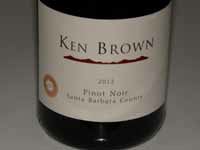 2012 Ken Brown Santa Barbara County Pinot Noir 14.2% alc., 656 cases, pH 3.71, TA 0.56, $35. Magnums available. Sourced from Rio Vista Vineyard, Garey Vineyard, Nielson Vineyard, Sierra Madre Vineyard and Buena Terra Vineyard. 53% from Santa Maria Valley and 47% from Sta. Rita Hills. · Moderately light reddish-purple color in the glass. Pleasing aromas of black cherries, ripe berries and echoes of oak. Very tasty black cherry core with hints of red hard candy and spice and an earthy undertone. A very approachable mid weight offering with mild tannins and a silky mouth feel. Almost weightless. You won’t find a better AVA blend in the marketplace. Score: 91
2011 Ken Brown Nielson Vineyard Santa Maria Valley Pinot Noir 14.1% alc., pH 3.66, TA 0.53, 231 cases, $42. A new vineyard designate from Ken. Sourced from a replanted block (2000) under the direction of Ken Brown in collaboration with the Mondavi family who owned the property at the time. High-density spacing of Dijon clone 115. · Medium reddish-purple color in the glass. Uplifting aromatics of dark cherries and spice with a hint of seasoned oak. Satisfying charge of earth-kissed black cherry fruit on the mid palate with a hint of dried herbs in the background. The tannins are suede-like and dry, the balance is spot on and the finish is replete with black cherry goodness. Nothing is out of place. An excellent cellar candidate. Score: 92
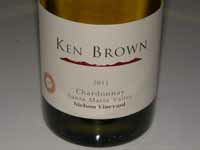 2011 Ken Brown Nielson Vineyard Santa Maria Valley Chardonnay 14.2% alc., pH 3.33, TA 0.63, 138 cases, $38. Sourced from replanted vines using cuttings from the original old vines including Wente clone. Ken has worked with this vineyard for more than 30 years. Whole cluster pressed, barrel fermented, 75% malolactic fermentation, aged sur lie 10 months in 17% new French oak barrels. · Light golden yellow color and clear in the glass. I was enchanted with the nose that offered aromas of tropical fruits, pear, buttered brioche and slate. Delicious compliment of lemon, baked pear and apple flavors with the slightest hint of complimentary French oak. The wine really brings you to attention on entry and holds on for a satisfying, acid-driven finish. Very soft in the mouth and appealing now, but has the balance for a long life in the cellar. Score: 94
2011 Ken Brown Rita’s Crown Vineyard Sta. Rita Hills Chardonnay 14.3% alc., pH 3.37, TA 0.64, 67 cases, $42. Inaugural bottling from this vineyard, one of the newest in the Sta. Rita Hills AVA (planted in 2007). One of the highest planted vineyards at 600 to 950 feet in the AVA. Soils are sandy loam with ancient seashell deposits. Dijon clone 76. Whole cluster pressed, 100% barrel fermented with 70% malolactic fermentation, and aged sur lie for 11 months in 17% new French oak barrels. · Light golden yellow color and clear in the glass. Attractive aromas of white peach, lemon curd and iron are replicated on the palate. The French oak is beautifully integrated offering the slightest hint of vanilla and toast. The wine is smoothly textured in the mouth and slightly viscous, with vibrant underlying acidity and some persistence of juicy green apple on the finish. Very classy. Score: 92
Littorai: Balance & Harmony is ThemeIt was 1997 and my love affair with Pinot Noir had just been rocked by the news that Williams Selyem was being sold. To borrow from the words to the song, “American Pie”:
I can still remember how That Pinot used to make me smile And I knew if Burt had the chance That he could make those people dance And maybe they’d be happy for a while But 1997 made me shiver With every Pinot I’d deliver I couldn’t take one more step But something touched me deep inside The day the Pinot died
It was a good friend, Master Sommelier René Chazottes, who saved my passion. I was lamenting to René about my loss when he related this endorsement to me in his understated way, “There is this winemaker named Ted Lemon who was trained in Burgundy, is very talented, and makes good wine. You might check out his wines.” I headed straight for a local restaurant that had Ted’s Littorai wines on the wine list and ordered the 1992 Thieriot Sonoma Coast Pinot Noir. The wine was an epiphany, a revelation, love at first sip. The wine had the elegance, purity and balance that I had come to enjoy in a Williams Selyem wine, but the wine had its own character, a beautiful marriage of classic Old World Burgundy and New World flair. Littorai Pinot Noir quickly became the yardstick that I used to judge all other North American Pinot Noirs against. Although I have sought balance and harmony elsewhere and found it in a number of wines, I have always returned to Littorai as the standard.
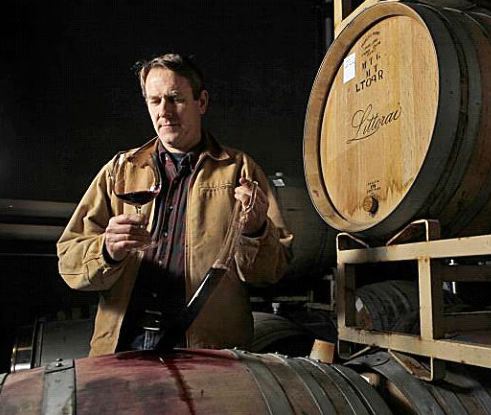 Ted’s story has been elucidated in detail in past issues of the PinotFile, but I will briefly note the high points here. In the mid 1980s, he returned to the United States from his winemaking tour at Domaine Guy Roulot in Meursault (Ted remains the only American ever to be the winemaker and vineyard manager at a major domaine in Burgundy’s history), and was hired by a French family to be the founding winemaker and vineyard manager for Chateau Woltner on Howell Mountain. The winery’s Chardonnays soon became a favorite among American wine connoisseurs. Once Ted’s winemaking and vineyardist skills were assured, he founded Littorai Wines in 1993. Ted believed the finest Pinot Noir and Chardonnay were grown along the true littoral (Latin for coastal) zone of the continent. He was convinced that the geology and mesoclimates of the extreme portion of the continent north of San Francisco were diverse enough to create a series of unique terroirs and his conviction has since been confirmed. Ted was one of the first winegrowers who believed world class wine production could be achieved in California using low yields, proper clones, vertical trellising, leaf removal, and other now commonly used viticultural practices. He was the first to create “by-the-acre” contracts for wine grapes in which he personally and closely supervised all aspects of vineyard management. This type of contract is now the norm for premium Pinot Noir growers in California and Oregon. Ted was the first to vineyard designate Savoy Vineyard, Mays Canyon Vineyard and Charles Heintz Vineyard. He had a lengthy relationship with Summa Vineyard that was absolved through vineyard ownership change in recent years, and has enjoyed long-term committed relationships with Cerise Vineyard, One Acre Vineyard (part of Savoy’s Deer Meadow Ranch), Roman Vineyard, Hirsch Vineyard and B.A. Thieriot Vineyard. In addition, Littorai has developed estate vineyards including Pivot (pictured below), The Haven and The Tributary.
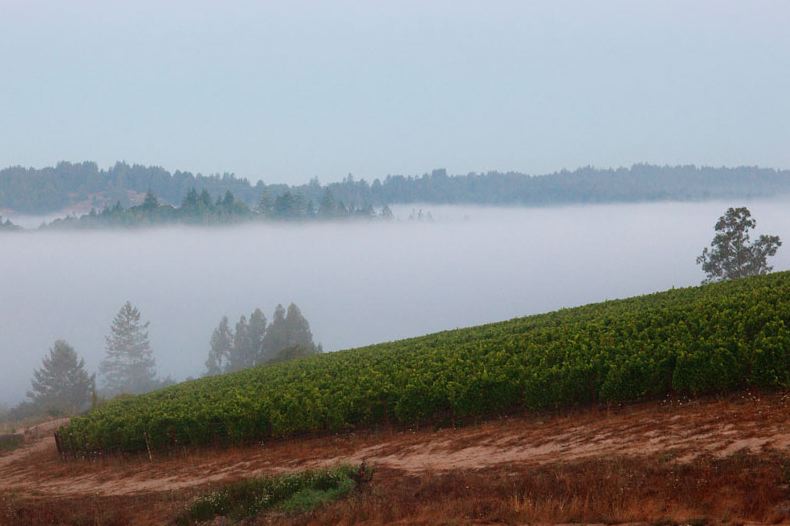 Practically all Littorai’s vineyard sources are farmed organically and more than half are farmed biodynamically which Ted embraces wholeheartedly. He believes the clearest path to achieve wines of classic balance in California’s dry summers is biodynamics. “We can produce vines which express the year and yet overcome its greatest challenges, all in a self sustained, self contained model.” Ted’s winemaking emphasizes minimal intervention and gentle handling of the fruit and wine. The Pinot Noir wines are fermented in traditional open-top fermenters and at least some proportion of whole clusters are used. All the wines undergo native yeast fermentation and complete malolactic fermentation, as long as nature does not dictate otherwise. The goal (and what I find most appealing) is to avoid overripe flavors and high alcohol levels, and focus on finesse, balance and length. Usually one-third to one-half new French oak is used for aging the wines as an element of complexity, but one is never led to think of oak when tasting a Littorai wine. Littorai wines can age extremely well and I would suggest that if you ever find older vintages of Littorai Pinot Noir and Chardonnay in the secondary market, buy them. Ted says the 2000, 2002 and 2007 Pinot Noir vintages are drinking beautifully now A functional, but not extravagant winery was completed on the Littorai estate in time for the 2008 vintage. The winery is a straw bale walled building constructed on two levels on the side of a hill and is where Ted and his staff receives visitors. Visitors are offered both current releases and library wines for tasting. The intimate tasting experience is available by appointment only, Monday through Saturday, for a small charge. Phone 707-823-9586 or visit the website at www.littorai.com for appointment information. Littorai wines are available exclusively through a mailing list and fine restaurant placement throughout the United States. The wines often sell out quickly and are sold on a first-come, first-served basis. Wines can be picked up at the annual fall open house in October or shipped to your address. If you only splurge on one ultra-premium California Pinot Noir producer each year, Littorai should be a top consideration. Ted is a life long winemaker passionately committed to his craft. He did not come into wine as a second career. His wines adhere to a personal esthetic sensibility and his impressive track record of consistent excellence with multiple vineyard sources spans twenty years. Ted described the 2011 vintage as follows. First, the good news: “A classic terroir driven vintage with each vineyard displaying its traditional personality. This is a vintage where you can trust in the character of place. The wines possess density, structure and acidity wrapped in a dark, woodsy and earthy bouquet. The vintage will age very well so hold the 2011s for at least three to five years if you can manage it!” Now the bad news: “2011 vineyard designated Pinot Noir production is the lowest since 2005.” The winter 2011 releases included the 2012 Sonoma Coast Vin Gris of Pinot Noir, and the 2012 Sonoma Coast and Les Larmes Anderson Valley appellation Pinot Noirs. The 2011 single vineyard releases include Pinot Noir from Cerise Vineyard, Savoy Vineyard, One Acre Vineyard and Roman Vineyard in the Anderson Valley, Hirsch Vineyard, The Haven Vineyard, Pivot Vineyard, Platt Vineyard, and B.A. Thieriot Vineyard in the Sonoma Coast, and Mays Canyon Vineyard in the Russian River Valley. The following reviews are from a few of the wines that I tasted recently. Still very young, the aromas literally jumped out of the glass when tasted a day after opening. All the wines displayed spectacular elegance, freshness and transparency.
2011 Littorai Savoy Vineyard Anderson Valley Pinot Noir 13.9% alc., $65. · Moderately light reddish-purple color in the glass. Welcoming scent of cherry, earthy flora, spice and balsam. Very elegant and demure, yet flavorful, with tastes of strawberry, cherry, and spice on the mid palate, and some rose water and spiced maraschino cherry on the bright finish. Very soft in the mouth with a subtle oak sheen and gossamer tannins. The most forward and feminine of the wines tasted here, but like red lingerie, delicate yet alluring. Score: 90
2011 Littorai Roman Vineyard Anderson Valley Pinot Noir 12-year-old vines farmed biodynamically since 2008. 13.1% alc., $65. · Moderate reddish-purple color in the glass. Soaring scents of black cherry, exotic flowers, and oak spice. Haunting, deep cherry and berry flavors with hints of spice, white pepper and vanilla. More body, power and length than the Savoy bottling, with a tannic structure that enhances the fruit, yet the wine is still perceived as elegant. A David Bowie wine that is neither masculine or feminine. Score: 92
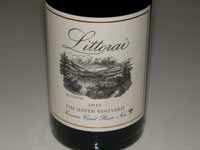 2011 Littorai The Haven Estate Bottled Sonoma Coast Pinot Noir 13.3% alc., $80. · This is a wine that will make you sit up in your chair. The darkest wine of those tasted here with a moderately dark reddish-purple hue in the glass. The nose offers brooding aromas of black cherries, black raspberries, black currant, seasoned oak and forest floor. Delicious, round, polished and sassy with plenty of enticing sappy dark red and black fruit. The velvety mouth feel is quite sensual and the juicy finish leaves the hair stand up on your nape. Terrific the next day from a previously opened and re-corked bottle. Score: 94
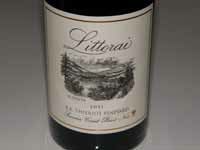 2011 Littorai B.A. Thieriot Vineyard Sonoma Coast Pinot Noir 12.9% alc., $75. · Medium reddish-purple color in the glass. The chameleon of a nose unfolds slowly offering a wide array of aromas including black cherry pie glaze, black raspberry jam, tea leaf, smoked bacon, and exotic spices. Quite reserved, offering its charms slowly over time in the glass to reveal a hearty core of black berry and stone fruit flavors enhanced by subtle oak notes. The dry tannins tend to dominate at this young age, but I can see through that as I have drank plenty of bottles of Thieriot Pinot Noir. The big, lengthy peacock finish elevates this wine to another level. In the words of Jan McInerney, “I’m obsessed, crazed with lust, spending ridiculous amounts of money on the object of my desire. Because when she’s good, she’s very, very good.” Score: 95
I tried a little experiment at the end of my tasting, but Ted, who is a firm proponent of terroir will cringe, so don’t tell him about my experiment in terroir (or was it terror?). Wine is supposed to be fun, right? I mixed equal small parts of each of the above four wines just to see what would result. The blend exhibited satisfying black cherry, black raspberry and oak spice aromas. It was very tasty on the palate with impressive fullness and displayed the full spectrum of dark red and black fruit. The problem was that it tasted muddled, uniform, even corporate. The wine was very pleasant but not distinctive and any nuances were blurred. I clearly preferred the vineyard designated bottlings for their complexity and individuality. Don’t try this experiment at home.
Dijon Clone 943: Early ReportsENTAV-INRA® clone 943 originated in the Côte-d’Or and was introduced in 1989. There is very little published performance information so only generalizations can suffice at this time. It is one of the few Dijon clones that the French have negotiated a royalty payment for every bud sold here in the U.S., so very few nurseries sell the clone. 943 was sent to FPS at Davis in 1997 along with 667, 236 and 743. 667 was registered in the California R&C Program in 2001 and 943 in 2004. A photo of a typical 943 cluster and comparison to 115:
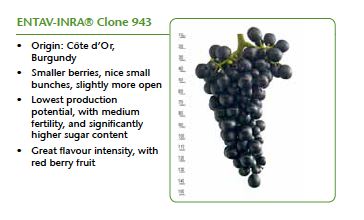
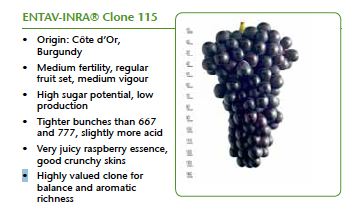 Adam Lee of Siduri gave me this photograph below of a cluster of 943 (right) next to 777 picked on the same day from adjacent sections of Sierra Mar Vineyard in the Santa Lucia Highlands. Note the smaller berries, the chicks and the small bunch size of the clone 943. Adam “loves it” and bottled a single clone 943 Pinot Noir from Sierra Mar Vineyard in 2009. He notes that the wine from 943 is not terribly dark and not particularly tannic. His Sierra Mar vineyard designated Pinot Noir often combines clone 23, 943, 777 and Pommard and he relishes its vibrant dark fruit, richness, depth and mid-palate pliancy. Adam said that 943 is definitely the most different Dijon clone he has worked with and offered further details. He said, “943 definitely has some of the smallest berries we have. Often times the berries are seedless. Because of this, we often choose to pick it early since those tiny seedless berries go away if any heat arises. You can get a pretty good crop with 943 but you need to leave more clusters as the clusters are low in weight (with most clones we get 4 to 5 clusters per pound but with 943 it more like 8 to 10 clusters per pound).”
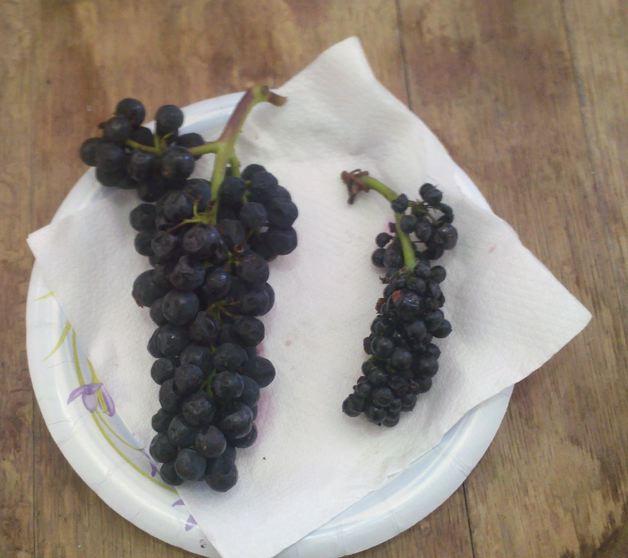 Besides the characteristics noted above, clone 943 has been reported to have medium to low titratable acidity, medium to high polyphenol and anthocyanin production, low yields, medium to low berry size, medium bunch number per shoot and early ripening. The clone has the lowest yield compared with 777, 667, 114 and 115. The wines are aromatic with sometimes atypical aromas. Tannins are sometimes too supple and velvet. According to David Adelsheim, the interest in clone 943 seems to have been the result of a push from ENTAV to position the clone as a producer of top quality wines. However, the Catalogue des Variétés et Clones de Vigne Cultivés en France from 1995 rates the clone with a “B” (not an “A” like 777 and 828). Adelsheim speculates that perhaps ENTAV was impressed by the low crop levels. Adelsheim has 943 planted at Richards Vineyard and Fennwood Vineyard but the vines are still very young (planted in 2008). So far, David and winemaker Dave Paige are not very excited about it. They have found in their vineyards that the clone is a light producer due to the number of chicks and may be challenging to hit sensible economic yields in light set seasons. Paige notes that the wine produced from 943 has “a very plummy, ripe quality we find a little over the top.” He feels the quality might be better with more hens and fewer chicks. That said, the experience at Adelsheim is very limited. John Kelly, the winemaker at Westwood Winery in Sonoma, has had experience with clone 943. He told me the following. “I continue to like this clone, especially for its aromatics. As the vines have matured, I am seeing more regular yields and fewer hens and chicks, though it is possible that this is just a function of the really good set we have had the last two vintages. With the more completely seeded fruit has come a more full mid-palate on the wine. It still does not develop the textural interest of 115 or 777. The tannin content of the finished wine is still weak compared to other Dijon clones and 943 remains a selection that I believe requires blending with another more tannic clone to achieve a balanced wine. My 943 is the earliest-ripening of my Dijon clones.” Winemaker Mike Sullivan of Benovia Winery in the Russian River Valley told me he has 943 planted at two different vineyard sites. The Tilton Hill Vineyard is located in Freestone and 943 has been harvested for three years from this site. The clone has shown a propensity for millerandage (shatter or shot berries) with tiny berries and abnormally small clusters. The cluster weights are very low weighing in around 40-50 grams per cluster. The wines tend to be dark in color with enormous concentration, medium high acidity and fine tannins. 943 has also been planted at Martaella Vineyard adjacent the winery and has been harvested for one year. The clone has exhibited millerandage here as well with very low cluster weights of 60-70 grams per cluster. Mike attached a photo of 943 from this site: In summary, Mike said, “It is a very low yielding clone that may not be commercially viable for some growers. In my experience, yields on the 943 have been 40% to 50% of other Dijon clones and about half the yield of the Calera selection. It is a very high quality clone that because of seedless berries is susceptible to dehydration from heat spikes."
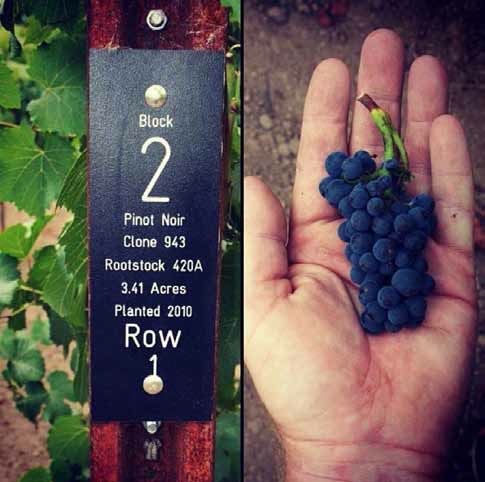 Dave Jepson, the winemaker at Treos Wines in the southern Willamette Valley said that the 943 clone planted at Treos had a very expressive nose with flavors of black fruits (black cherries and dark plums) and some earth and truffle notes. The 943 is similar in tone to 667 and 777 but has a bit more of a “savage” edge to it. He wishes he had planted more as he feels it adds complexity to the Treos Pinot Noirs without sacrificing depth and richness of flavor. Single clone 943 Pinot Noir has been released by Paraiso Vineyards (reviewed below), Siduri and Melville. Clone 943 is currently planted at numerous sites in Oregon (Adelsheim, Treos, Keller Estate, Beaux Freres, Johan), California (Alder Springs Vineyard, Benvoia, duMOL, Dry Stack Vineyard, Hahn Estate, J Vineyards & Winery, Lone Oak Vineyard, Martin Ray, Melville, Morgan, Righetti Ranch, Sierra Mar Vineyard, Tondre Grapefield, Westwood Estate), and New Zealand (Burn Cottage, Two Paddocks).
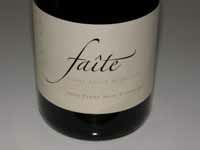 2009 Paraiso Vineyardes faîte Clone 943 Santa Lucia Highlands Pinot Noir 14.4% alc., pH 3.81, TA 0.59, 50 cases, $50. Limited release. Aged 10 months in French oak barrels. Winemaker Dave Fleming. Moderately dark reddishpurple color in the glass. Exotic nose with scents · Moderately dark reddish-purple color in the glass. Exotic nose with scents of earthy flora, conifer, black fruits and oak. Delicious mid palate array of full-bodied, in-your-face, dark red and black berry fruits wrapped in suave, fine-grain tannins. Very smooth and seamless with well integrated acidity, complimentary oak, and a stunning, lengthy finish. The intense fruit sap really stars in this wine. Score: 91
Hahn Estates: Consistently Top NotchHahn Estates debunks the misconception that large corporate wineries cannot produce outstanding Pinot Noir. The Hahn Family Wines lineup includes Pinot Noir under the Hahn Winery, Cycles Gladiator, Bin 36, Hahn SLH Estate and Lucienne labels. Total production of all Hahn Family Wines is about 400,000 cases annually from winery facilities in Soledad and Lodi (Cycles Gladiator label), making the winery one of the top thirty producers in North America. Located on the Monterey Coast in the Santa Lucia Highlands, Hahn Estates farms about 653 acres of vineyards in the Santa Lucia Highlands, 350 acres in Arroyo Seco and 160 acres in Paso Robles. The winery did not have a single Pinot Noir vine in 2000, but now has about 620 acres of Pinot Noir with 20 clones and is a leading producer of Pinot Noir and a supplier of Pinot Noir grapes to many other premium wine producers. Hahn Estate is the largest grower of Pinot Noir in the Santa Lucia Highlands AVA. The three vineyards in the Santa Lucia Highlands include Lone Oak Vineyard (146 acres of Pinot Noir, Chardonnay and Pinot Gris), Doctor’s Vineyard (243 acres of Pinot Noir and Syrah) and Smith & Hook Vineyards (254 acres of Pinot Noir, Chardonnay, Syrah, Grenache and Malbec). In the Arroyo Seco, the two vineyards include Ste. Phillippe Vineyard (290 acres of Pinot Noir, Merlot and Grenache) and Ste. Nicholas Vineyards (171 acres of Pinot Noir and Chardonnay). Andy Mitchell is the director of viticulture for Hahn Estate and Mesa Vineyard Management directs the farming operations of the estate vineyards. Much of the grapes are mechanically harvested. Founder Nicolaus (Nicky) Hahn is a Swiss businessperson, adventurer and philanthropist who became enamored with California wines while living in England, leading him to buy the Smith & Hook Winery in 1980. In 1991 he started the Hahn Estates brand and was one of initiators involved in creating the Santa Lucia Highlands AVA. In German, Hahn means “rooster,” and the rooster is prominently displayed on the Hahn Estate label.
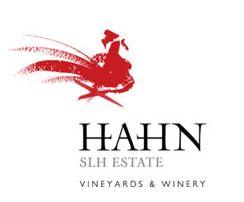 The current Director of Winemaking is Monterey native Paul Clifton who learned his winemaking under veteran Don Blackburn at both Bernardus Winery and Byington Winery. After obtaining a graduate degree focused on cool climate viticulture from Lincoln University in New Zealand, he started at Hahn Estates in late 2002, and quickly assumed the position of head winemaker. Clifton’s assistant is Greg Freeman. When it comes to excellent value-priced Pinot Noir, no winery in California does it better than Hahn Estates. Hahn also has an ultra-premium Pinot Noir label, Lucienne, offering estate vineyard designated wines first released from the 2005 vintage. The Lucienne estate winery is a separate facility: a winery within a winery. The winery takes its name from Nicky Hahn’s middle name Lucien, but in the feminine form to honor the namesake of the Santa Lucia Mountain range where the vineyards are located. The 2006 and 2007 vintages were outstanding, the 2009 less so (the 2009 wines were originally reviewed in 2011 but tasted recently again with a better impression), and the 2011 wines are extraordinary. Hahn SLH Estate Culinary Center, a wine trade education venue, is located in Soledad and shares the panoramic views of the Hahn Estate Vineyard with the Santa Lucia Highlands. The Center is a space for seminars and wine tastings as well as a professional demonstration kitchen to allow pairing of gourmet and local foods with Hahn Estates wines. The Culinary Center is nothing new to other wine regions of California, but it is the first facility of its kind in Monterey County. Vineyard tours and tastings are offered at the winery Visitor’s Center and a unique estate ATV educational adventure includes a Reserve tasting in the VIP room. The tasting room is open daily at 37700 Foothill Road in Soledad. Visit the website at www.hahnestates.com for more information. Hahn is one of the ten tasting rooms on the regional River Road Wine Trail that parallels Highway 101 at the foot of the Santa Lucia Mountains. Visit www.riverroadwinetrail.com. The wines reviewed below are SIP (Sustainability in Practice) certified.
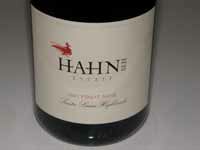 2011 Hahn Estate SLH Santa Lucia Highlands Pinot Noir 14.5% alc., pH 3.60, TA 0.62, 5,000 cases, $35. Released October 2012. Sourced from four estate vineyards (Smith, Doctor’s, Hook and Lone Oak). Clones are 113, 115, 667, 777, 2A, Mt. Eden, Pommard 5, Jackson 9. 100% de-stemmed, aged 11 months in 40% new and 60% neutral French oak barrels. · Medium reddish-purple hue in the glass. Aromatically stellar from the get go with scents of black cherry, black raspberry, spice and a touch of smoky oak. Easy to like on the moderately lush palate with a core of black cherry fruit wrapped in gentle tannins, showing an undercurrent of smoky oak and anise. A forward drinking wine that is quite enjoyable. Score: 88
2009 Lucienne Lone Oak Vineyard Santa Lucia Highlands Pinot Noir 14.5% alc., pH 3.70, TA 0.61, 138 cases, $50. Released May 2011. Aged in 35% new French oak barrels. · Moderately dark reddish-purple color in the glass. The nose is alive with aromas of cherry pie, black grape and plum with hints of spice and smoky oak. Rich and fruit-driven on the palate with an array of very ripe dark cherry and berry fruits backed by smoky oak. Very polished tannins, a soothing mouth feel and a big finish that really hangs on. Score: 89
2009 Lucienne Doctor’s Vineyard Santa Lucia Highlands Pinot Noir 14.5% alc., pH 3.58, TA 0.63, 647 cases, $50. Released May 2011.Aged in 35% new French oak barrels. · Moderately dark reddish-purple color in the glass. This wine pushes the ripeness envelope with aromas of black cherries, black raspberries and black currants accented by spice, sandalwood and vanilla, and flavors that mimic the aromas with an added undertone of smoky oak and anise. Very silky and harmonious with a satisfying fullness on the palate. Score: 87
2011 Lucienne Lone Oak Vineyard Santa Lucia Highlands Pinot Noir 14.5% alc., pH 3.68, TA 0.64, 425 cases, $50. Released June 2013. Lone Oak is smallest and northernmost Pinot Noir estate vineyard. The cool 2011 vintage resulted in a relatively small crop, but the grapes that were harvested had greater intensity and concentration. Clones Pommard 5, 667 and 115. 100% de-stemmed, 3-day cold soak, native and proprietary yeasts, aged 13 months in 40% new and 60% neutral French oak barrels. · Moderately dark reddish-purple color in the glass. Scandalous aromatics featuring bright aromas of red cherries, raspberries, sandalwood and spice. A chewy wine that you want to nibble with a perfectly ripened array of red stone and berry fruits. Soft and nimble, with delicate dry tannins and a refreshing cut of acidity on the ridiculously long finish. This beauty has the balance that predicts longevity in the cellar. Score: 94
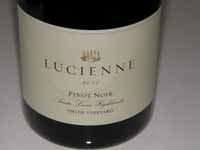 2011 Lucienne Smith Vineyard Santa Lucia Highlands Pinot Noir 14.5% alc., pH 3.55, TA 0.66, 438 cases, $50. Released June 2013. One of the first vineyards in the Santa Lucia Highlands and one of the original vineyards of Hahn Estate. It is the southernmost of the vineyards of Lucienne and located at the highest elevation, with the least influence from marine fog. Clones are Mt. Eden, Jardini, Pommard 5 and 2A. 100% de-stemmed, 3-day cold soak, proprietary yeast, aged 13 months in 42% new and 58% neutral French oak barrels. · Moderately dark reddish-purple color in the glass. Intoxicating aromas of fresh black cherries, dark red berries, cardamom spice and a hint of toasty oak. Discreetly concentrated flavors of dark cherries and berries with a complimentary riff of spice and oak. Outstanding harmony, very smooth and sensual, with an appealing cherry tang on the juicy and lengthy finish. The wine continues to pick up charm over time in the glass. Very easy to drink now, but should get even better with another year in bottle. Very impressive, even extraordinary. Score: 95
Mueller: Over 20 Years of Excellence in the Russian River ValleyWhen talk turns to the established wineries of the Russian River Valley, the names Gary Farrell, Rochioli, and Williams Selyem are often trumpeted. Less well known, but no less accomplished, is Mueller Winery, founded by Robert Mueller in 1991. Robert received a bachelor’s degree in biology from the University of California at Santa Cruz and worked at Paul Masson Champagne Cellars in Saratoga as a chemist. He soon made the decision to become a winemaker and attended the University of California at Davis where he earned a masters degree in food science and enology. After graduation, he worked as a winemaker at Foppiano Winery, Charles Krug Winery, Pirelli-Minetti Winery, and in 1981, he became the Director of Winemaking for Souverain Winery. Three years later, he founded his own wine consulting business. In 1991, he launched Robert Mueller Cellars with the production of 315 cases of “LB” Russian River Valley Chardonnay. The first “Emily’s Cuvée Russian River Valley Pinot Noir was produced from the 1994 vintage and became the winery’s flagship bottling. Initially the winery was located in Healdsburg, ten years later it was relocated to Windsor, and in 2013 returned to Healdsburg.
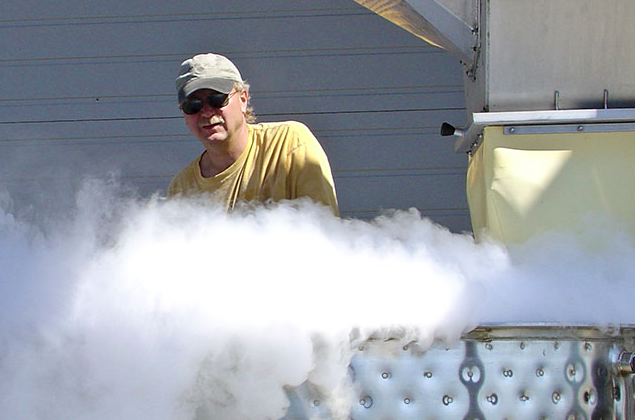 A new tasting room opened June 1, 2013, across from the Raven Performing Arts Center in Healdsburg at 118 North Street. It is open Thursday through Monday. The Mueller Starr Road winery facility in Windsor was sold in May 2013, and production was moved for the 2013 harvest to a new modern winery, Punchdown Cellars, a custom crush facility in Santa Rosa. Production is about 4,000 cases annually. The winery is largely a two person operation with Robert handling the cellar and production duties, while his spouse Lori manages sales, accounting and compliance work. Mueller wines are available in the tasting room, on the website at www.muellerwine.com, and throughout the United States through retail channels. Mueller is best known for Pinot Noir, but produces several other varietals based on grapes sourced from the Russian River Valley. The Pinot Noirs are lush, extravagantly fruity wines exhibiting the bright cherry and cola flavors and moderately high alcohols that are the hallmarks of warmer Middle Reach Russian River Valley vineyard sites. The wines are comparable in style to J. Rochioli, Merry Edwards and Kosta Browne Russian River Valley Pinot Noir. Grapes are typically picked at or above 25º Brix at harvest, 100% de-stemmed, fermented in 2-ton custom fermenting tanks using both indigenous and inoculated yeasts, and aged in 30% to 40% new French oak barrels. Mueller’s Pinot Noir vineyard sources are Vino Farms located east of Eastside Road (see map below). Vino Farms is one of California’s largest wine grape growers along with Bronco and Gallo.
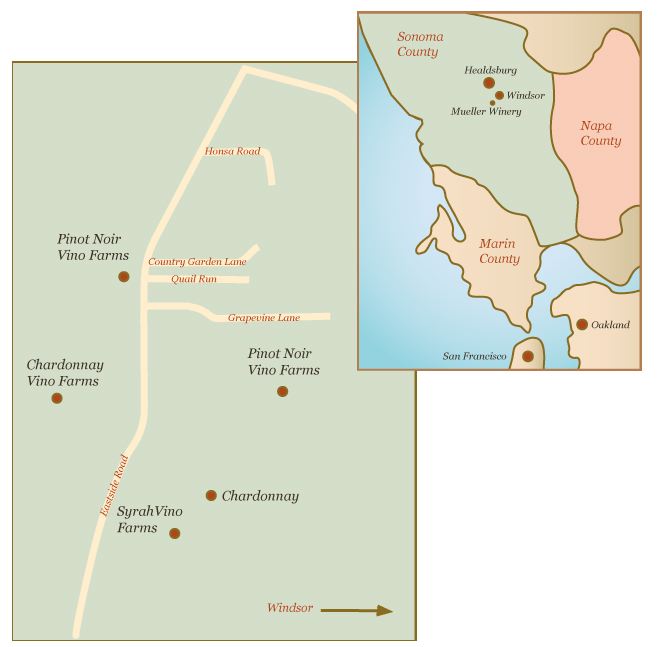 The 2011 “Harvest of Long Faces” produced solid wines from Mueller.
2011 Mueller Emily’s Cuvée Russian River Valley Pinot Noir 14.9% alc., pH 3.60, 412 cases, $48. Produced from a vineyard farmed by Vino Farms near the banks of the Russian River directly across the river from Rochioli and Allen Vineyards in the Middle Reach of the appellation. Clones 667, 115, 777 and 2A. Harvest Brix 25.2º. 100% de-stemmed, indigenous yeast fermentation, aged in 33% new French oak barrels. · Medium reddish-purple color in the glass. Aromas of black cherries, fully ripened strawberries, baking spices and oak vanillin lead to moderately rich flavors of Bing cherries, cola and spice. Round and polished, gentle and agreeable, with mild tannins and good underlying acidity, finishing with a burst of cherry. Like the most popular girl in school: smells wonderful and is very likable. Score: 90
2011 Mueller Eastside Russian River Valley Pinot Noir 14.9% alc., pH 3.60, 85 cases, $48. Clones 667, 115, 2A planted on Eastside Road in the Middle Reach of the Russian River Valley. Harvest Brix 25º. 100% destemmed, aged in 34% new French oak barrels. · Moderately dark reddish-purple color in the glass. Fruity nose offering aromas of grapes, plums and blueberries. Rich and velvety on the palate with an array of blue and purple fruits with a hint of dark chocolate and oak. Easy to drink with balanced tannins and a soothing finish. Pleasant but not memorable. Score: 88
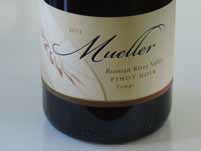 2011 Mueller Tempi Russian River Valley Pinot Noir 14.7% alc., pH 3.50, 146 cases, $48. Produced from a select vineyard block of Dijon 777 situated on a well-drained, gravelly site that is part of Vino Farms. The block is located less than one mile from the Russian River and directly across the river from Rochioli and Allen vineyards in the Middle Reach of the appellation. Harvest Brix 25.0º. 100% de-stemmed. Aged in 40% new French oak barrels. · Medium reddish-purple hue in the glass. Bright nose featuring aromas of Bing cherries, cola, balsam and floral perfume. Rich, luscious and full-bodied on the palate, yet soft and polished, offering flavors of black cherries, black raspberries and black plum, finishing on a high note with plenty of spiced fruit. The vivid fruit in this wine elevates it to a higher level. Score: 92
2011 Mueller Cuvée X Russian River Valley Pinot Noir 14.9% alc., pH 3.80, 68 cases, $48. Produced from a select vineyard block of Martini 15 and most Dijon clones located on Saralee’s Vineyard in the Middle Reach of the appellation. Normally this wine is crafted solely from the Martini clone, but the source in 2011 suffered untimely · Moderate reddish-purple color in the glass. Appealing aromas of blackberry jam, black cherry liquor and dark rose petals. Rich and flavorful, with intense black cherry and dark berry fruits with sous-bois and oak adding to the cadence. The sappy fruit is nicely balanced by broad shouldered tannins. Score: 91
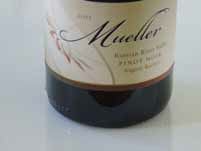 2011 Mueller August Recher Russian River Valley Pinot Noir 15.1% alc., pH 3.60, 138 cases, $48. Produced from clones 667 and 777 planted in Vino Farms vineyard situated in the Middle Reach of the appellation. Harvest Brix 25.2º. 100% de-stemmed. Aged in 35% new French oak barrels. · Medium reddish-purple color in the glass. The nose opens slowly in the glass to reveal aromas of ripe Bing cherries, cassis and complimentary oak. Rich and delicious, with deep cherry flavor and a complimentary oak sheen. Oozing luscious sap, but still soft, gentle and juicy with a seamless character. The finish is noteworthy for its palate staining, generous fruit statement. Judged on power with class, this wine stands out from the crowd. Score: 93
2011 Mueller Hogan’s Run Russian River Valley Pinot Noir 14.9% alc., 78 cases, $48. Named for the winery’s beloved black Labrador retriever, Hogan, this 6-acre hillside vineyard owned by Susie and Fred Sedlacek. Inaugural release from this vineyard. Clone 667. · Moderately dark reddish-purple hue in the glass. Very shy nose showing demure aromas of dark cherries and berries. The palate is well ahead of the nose, strutting a full-bodied, sappy core of very ripe black cherry fruit with a hint of cola and wood spice. The prodigious fruit is clothed in muscled tannins. Amazing persistence on the long, and I mean long, cherryinfused finish. Score: 91
Sips of Recently Tasted Pinot NoirHere are a number of outstanding wines to grace your holiday table and greet your guests in style. The 2012 vintage wines are beginning to appear in the marketplace and offer remarkably concentrated flavors that reflect the ideal growing season. Budbreak happened on schedule, fruit ripened slowly and evenly in the relatively mild conditions, and concentration and lush fruit character developed over an extended hang time on the vine.
2012 CrossBarn by Paul Hobbs Sonoma Coast Pinot Noir 14.1% alc., $35, screw cap. A blend of selected vineyards in the Sonoma Coast AVA. 15 day total maceration, fermented using native and select yeasts, aged 10 months in 10% new oak barrels. Unfined and unfiltered. · Moderate reddish-purple color in the glass. Welcoming nose featuring aromas of black cherry pie, wild raspberries and weathered oak. Middleweight flavors of cherry cola, raspberry and spice with supportive oak in the background. A very pleasing wine with balanced tannins, a velvety palate and juicy acidity. Impressive wine in this excellent vintage. Score: 90
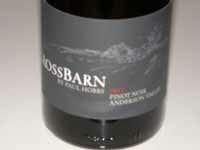 2012 CrossBarn by Paul Hobbs Anderson Valley Pinot Noir 14.1% alc., $35, screw cap. From select vineyards in the Anderson Valley. 16-day total maceration, fermented using native and select yeasts, aged 10 months in 14% new oak barrels. Unfined and unfiltered. · Moderately dark reddish-purple color in the glass. Reserved but pleasant aromas of red and black berry mash with a hint of spice and dried rose petals. Hits the mid palate with vigor, offering deliciously rich black cherry, blackberry and plum flavors accented with Christmas spice including clove. Highly approachable and comforting with supple tannins, bright acidity, and a glorious finish of uncommon intensity and length. By this one by the case for your holiday parties. Score: 91
2011 Davis Bynum Jane’s Vineyard Russian River Valley Pinot Noir 14.5% alc., $35. 107 acres of Pinot Noir in the Santa Rosa plain region of the Russian River Valley. Clones 113, 114, 115, 777, 667, 2A and 23 planted in shallow, well-drained, low-vigor, gravelly loam soil. Aged 10 months in French oak barrels. Winemaker is Greg Morthole. · Moderately light reddish-purple color in the glass. Russian River Valley signature Bing cherry and spice on the nose. Soft, smooth and pleasing, with mid weight flavors of cherry pie, cola and baking spice. Plenty of dark cherry shows up on the lengthy finish which leaves a tease of oak in its wake. Score: 89
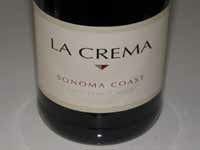 2012 La Crema Sonoma Coast Pinot Noir 13.5% alc., pH 3.74, TA 0.56, $25. Sourced from select vineyard sites in proximity to the Pacific Ocean. Clones 667, 777, 115, Pommard, 2A, Martini, Flowers, Calera, “828,” and 23. 100% de-stemmed, 3 to 4-day cold soak, fermented in small, open-top tanks, minimal post-fermentation maceration, aged in 26% new (98% French) oak barrels for 6 months. Racked only once for blending just before bottling. · Moderately light reddish-purple color in the glass. Enticing aromas soar from the glass including cherries, berries, purple grapes and earthy flora. Very tasty juice with excellent depth and length offering an arsenal of flavors including dark red strawberries and cherries, cola and gregarious spice with a dusting of oak enhancing the experience. Nicely crafted, with supple tannins and a long, caressing finish. As good or better than many Pinot Noirs in the marketplace costing twice as much. Score: 92
2010 Loos Family Bohemian Vineyard Russian River Valley Pinot Noir 13.5%, pH 3.70, TA 0.71, 50 cases, $44, 375 ml bottle. From a 7-acre vineyard in Freestone planted on Goldridge soil. Clones 115, 667, 777 and Pommard. Aged in 50% new French oak barrels. Previously tasted in February 2012. · Moderately dark reddish-purple color in the glass. Deeply perfumed with aromas of dark berries, black cherries, dark chocolate, Asian 5-spice, and oak. Mid weight flavors replicate the aromas with an earthy, forest floor undertone. The tannins are soft and the wine finishes with some intensity and persistence on the raspberry-infused finish Score: 89
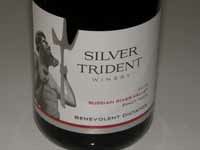 2010 Silver Trident Winery Benevolent Dictator Russian River Valley Pinot Noir 14.1% alc., 200 cases, $55. Aged in 40% new French oak barrels · My first experience with this winery and a good one. Moderate reddish-purple color in the glass. The nose brims with aromas of Bing cherries, baking spices and toasty, nutty oak. Very smooth and charming on the palate with mid weight flavors of dark cherry pie glaze, cola, red licorice and spice. Very classy and seamless with impeccable balance. The spiced cherry flavor was even more intense the following day from a previously opened and re-corked bottle. Score: 92
2012 Sineann Resonance Vineyard Yamhill-Carlton Willamette Valley Pinot Noir 14.8% alc, $44, Vino- Seal glass closure. · From a very ripe vintage and displaying a level of fruit concentration rarely seen in Pinot Noir from the Willamette Valley. Moderately dark reddish-purple color in the glass. Nicely perfumed with aromas of blackberry preserves, Hoison sauce and spice. Very tasty core of blackberry and black currant fruit with a dusting of oak. Full-bodied, round and satisfying, with substantial yet balanced fine-grain tannins, and a sappy finish of uncommon generosity. This one will spice up your life. Score: 91
 2012 Sineann Resonance Vineyard Reserve Yamhill-Carlton Willamette Valley Pinot Noir 14.8% alc., $66, Vino-Seal glass closure. Sourced from the oldest vines in the vineyard and composed of a few best barrels. · You won’t find Pinot Noir with such fat richness like this very often from Oregon. Dark reddish-purple color in the glass. Captivating nose of black fruits, dark chocolate and spice. A rich, pedal-to-the-metal offering featuring flavors of black berries, black currant, dark chocolate, tobacco, smoke and bacon-driven umami. The broad shouldered and grainy tannins nicely balance out the onslaught of prodigious fruit. Still palate staining the next day from a previously opened and re-corked bottle. This is one big rich pussycat. Score: 93
2012 Taft Street Russian River Valley Rosé of Pinot Noir 13.1% alc., pH 3.52, TA 0.51, 390 cases, $18. Cold soaked on its skins for 24 hours before pressing and then cold fermented in stainless steel tanks with minimal handling and fining. · Strawberry-pink color in the glass. Very aromatic with vibrant aromas of fresh strawberries, red cherries and yellow peach. Modest in weight, soft on the palate, and very pleasing with flavors of red berry fruits and a hint of dried herbs. The wine is quite enjoyable on its own as an aperitif or will pair well with Thanksgiving turkey. Score: 88
2012 Taft Street Russian River Valley Pinot Noir 14.5% alc., pH 3.65, TA 0.60, 4,211 cases, $25. Taft Street is a long time successful producer in the Russian River Valley, and claims its lineage to 1979. Aged in 10% new French oak barrels. · Medium reddish-purple color in the glass. Aromas of black cherry, bramble and earthy flora. Fresh flavors of Rainer cherry, strawberry, spice mix and toasty oak. Modest in weight with lithe tannins and appealing finesse making it appropriate for current drinking. Score: 88
2010 Westrey Abbey Ridge Vineyard Dundee Hills Willamette Valley Pinot Noir 13.5% alc., $42. · Moderately light reddish-purple color in the glass. The nose has a briar, dried oak and geranium theme with a delicate cherry fruit aroma. Much more appealing on the palate with flavors of red cherry, rhubarb and oak. Very elegant, with gossamer tannins, tangy acidity and a faint dried herb streak in the background. The oak tends to overshadow the fruit. This bottle is not up to the usual high standard of Westrey wines from this vineyard. Score: 86
2011 Winderlea Winderlea Vineyard Dundee Hills Willamette Valley Pinot Noir 12.9% alc., 751 cases, $60. Released May 2013. Pommard, Coury, 114, 115, 667 and 777 clones. Aged 10 months in 17% new French oak barrels. From a 20-acre vineyard first planted in 1974. · Moderately light reddish-purple color in the glass. The nose is replete with strawberry, cranberry, red cherry, dried herbs and hay aromas. Crisp and tangy on the palate with lighter weight flavors of dark red berries, spice, green tea and tarry oak. The dry tannins are powdery and the wine is easy to drink, but lacks fruit ripeness and power as a result of this cool vintage. Score: 87
A Life Worth Living: Russian River Valley Original Charles Bacigalupi 1924-2013The Russian River Valley community mourns the loss of noted winegrower, Charles Bacigalupi. He grew up in the suburbs of Santa Rosa where his family ran the local market named after the family, Bacigalupi Market, first established by Natale Bacigalupi in the early 1900s. Charles’ mother, Olive Gaddini (Olie) was a homemaker and artist. Charles’ father, Albert Bacigalupi, ran the local market and made wine that he sold in gallon jugs at his store. Charles attended local schools including Santa Rosa Junior College when his education was interrupted by World War II at the age of 18. He joined the navy and was assigned the duty of a dental assistant sparking his interest in the field of dentistry. After the war ended, Charles returned home and finished his prerequisites at Santa Rosa Junior College. He first met Helen Long in his final year of school there. Both Charles and Helen attended University of California at San Francisco and were married soon after their graduation in 1952. They returned to Healdsburg where Charles started his dental practice. He would practice dentistry in Healdsburg for the next 39 years. Helen was trained as a pharmacist, an unlikely profession for women of the time. Charles had a love of the land and had dreamed of owning his own ranch. In 1956 Charles and Helen bought the Goddard Ranch, 121 acres on Westside Road that was mostly planted with prunes, cherries and apples, with a few acres of Golden Chaslis, Mission, Muscat and Zinfandel grapes. In this era in the Russian River Valley, prunes, cherries, apples and peaches took precedent over wine grapes and were assigned to the prime growing sites, relegating grapevines to the poorest ground. Wine grapes were almost an afterthought since fruit trees were the money crop. Charles was at least hopeful that the sale of wine grapes would cover the property taxes. Neither Charles or Helen knew much about winegrowing, but they both had a green thumb, a scientific background, and enjoyed working in the outdoors. Through his dental practice, Charles got to know many of the local grape growers, including one patient in particular - Paul Heck. Paul and his brother Adolf L. Heck, Jr., had acquired Korbel Champagne Cellars in Guerneville in 1953. Charles was interested in expanding his limited wine grape plantings since the white grapes they were farming brought little income. Paul advised Charles to plant Pinot Noir and Chardonnay. He told Charles, “It’s cooler over there in the valley near the river.” Charles also heeded the advice of Bob Sission who was the farm adviser in Sonoma County for University of California at Davis. Sission also recommended the planting of Pinot Noir and Chardonnay based on the heat summation studies of Albert Winkler and Maynard Amerine. Charles reportedly had to write down the names of the grapes to keep from forgetting them and the only thing he know about those varieties was that they were grown in France. Neither Charles or the locals of the time had any interest in or knowledge of Pinot Noir and Chardonnay, the two varieties that now dominate the Russian River Valley landscape. Eventually, Charles obtained Pinot Noir and Chardonnay budwood from Karl Wente’s vineyard in Livermore. Charles first planted the budwood on the family’s home ranch in 1964, among the earliest plantings of Pinot Noir and Chardonnay in the Russian River Valley. The Pinot Noir selection is thought to be Pommard and the Chardonnay was the now ubiquitous Wente clone. Charles was a self-taught winegrower and learned about viticulture through experience and trial and error. His success is reflected in the countless wineries that have sourced Bacigalupi fruit through the years. Even when Charles was well into his late 80s, he could be found in his vineyards on a tractor disking the soil or in his garden tending to vegetables. Recently, Charles and Helen were honored by the Healdsburg Library and Historical Museum at their 15th Annual Pioneer Award Dinner. In addition, the Sonoma County Wine Library recorded and printed their oral history.
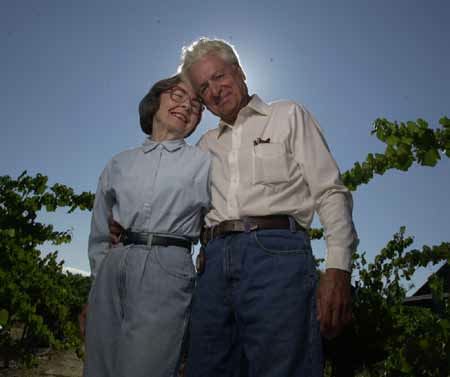 Charles is survived by his wife Helen Bacigalupi, son John Bacigalupi, and granddaughters Katharine Row Bacigalupi and Nicole Derrico Bacigalupi. John teamed with his spouse, Pam Heck Bacigalupi, and fourth generation nephew and winemaker Tyler Heck to found John Tyler Wines in 2002. John and Pam’s twin daughters, Katharine (Katey) and Nicole, became the face of John Tyler Wines and were instrumental in the building of a tasting room on Westside Road to feature the wines. To honor the legacy of the winegrowing Bacigalupi family, the name of the winery is being transitioned to Bacigalupi Wines, and the transition will be completed beginning with the 2012 vintage.
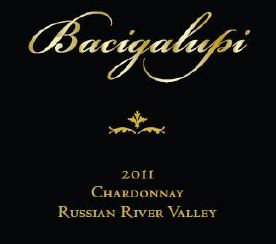 Read more: www.princeofpinot.com/article/1194/.
Pinot BriefsEntrepreneur Bill Price & Winemaker Gavin Chanin Introduce LUTUM Bill Price, owner of Classic Wines and Price Family Vineyards, along with Santa Barbara County winemaker Gavin Chanin, have launched a new Pinot Noir and Chardonnay label. LUTUM is Latin for “dirt” or “soil” and references the partner’s mission to make wines that reflect the great vineyards of California. The first wines will be released on November 12 through a mailing list offering and will feature small lots of 2011 Durell Vineyard Sonoma Coast Pinot Noir ($60) and 2011 La Rinconada Vineyard Sta. Rita Hills Pinot Noir ($50). Chardonnay will be added to the lineup beginning with the 2012 vintage, as well as additional vineyard sources including Bien Nacido, Gap’s Crown and Sanford & Benedict vineyards. Price, who owns part of the Durell Vineyard, the Gap’s Crown Vineyard and ownership interests in Three Sticks, Kistler, Kosta Browne and Gary Farrell wineries, was so impressed with Chanin’s winemaking talent and philosophical focus at such a young age (Chanin is 27-years-old), Price asked him to partner in a winery. Chanin was previously an assistant winemaker at Qupé and Au Bon Climat and has his own label, Chanin Wine Co. The wines are crafted at LUTUM’s new winery in Lompoc. For more information or to join the mailing list, visit www.lutumwines.com. Luisa Ponzi Celebrates 20th Vintage Second generation winemaker Luisa Ponzi celebrated her 20 years at the helm of Ponzi Vineyards with harvest 2013. The family winery, Ponzi Vineyards, was established in 1970 in Beaverton. After receiving a Bachelor of Science degree, Luisa moved to France in the early 1990s and received certification in viticulture and enology from the CFPPA in Beaune, France. She was the first American woman to complete the studies in Beaune. She was mentored by and worked with Christophe Roumier of Domaine Georges Roumier in Chambolle Musigny. Over the past 20 years, Luisa has mentored many budding winemakers including Andrew Rich, Josh Bergstöm, Greg McClellan, Thomas Houseman and Remy Drabkin. Beyond Oregon, Matt Dicey of New Zealand’s Mt. Difficulty and Thomas Bachelder of Bachelder Wines in Canada have worked with Luisa at Ponzi. One of Luisa’s greatest passions is Chardonnay. She has dedicated two decades to the study of Oregon Chardonnay. The Ponzi Reserve Chardonnay bottling has been presented at several noted White House dinners through the years. In 2012, Ponzi Vineyards unveiled the addition of two single vineyard Chardonnays to the portfolio: Avellana and Aurora. In 2008, Luisa and Dick Ponzi designed and built a modern, 30,000-square-foot winemaking facility. In June 2013, a modern new tasting room and offices opened at the same property as the winery, effectively moving the entire business operation from the original estate in Beaverton to Sherwood. View a video celebrating Luisa’s 20th vintage: http://ponziwines.com/blog/celebrating-luisas-20th-vintage/?utm_campaign=Luisa%27s %2020th%20Vintage&utm_medium=email&utm_source=newsletter&utm_content=Video%20about%20Luisa %27s%2020th%20Vintage
 French Wine Society 2014 Wine Immersion Study Trips to France. These unique trips offer an intensive, professional-level educational program on the ground in the wine region coupled with certification through the French Wine Society’s industry-endorsed Masters-Level program. The French Wine Society is a United States based nonprofit organization dedicated to French wine education. The trips are led by internationally experts in regions to be visited such as Andrew Jefford for Bordeaux, Kelly McAuliffe for the Rhone Valley and Elizabeth Gabay MW for Provence. The trips include high caliber wine tastings at some of the best estates in each region. They are nearly all inclusive with prices ranging from US $3,495 to US $3,895 per person, double occupancy, with each trip limited to 18 guests. Before each trip, participants get access to a Masters-Level Online Study program developed by the French Wine Society and after the trip, participants can validate their proficiency by passing the Masters-Level exam. For more information, contact jcamus@frenchwinesociety.org, call 1-202-640-5466, or visit the French Wine Society website at www.frenchwinesociety.org. California Pinot Noir Quality Has Skyrocketed An article in The Drinks Business (www.thedrinksbusiness.com, November 6, 2013) reported the findings of Karen MacNeil at last month’s California Wine Summit. She stated, “The quality of California Pinot Noir has skyrocketed faster than any other variety.” A total of 126 wines from 17 appellations in California were sampled double-blinded by five tasters including Karen MacNeil, and the highest scoring wines were from the Sta. Rita Hills, followed by Sonoma Coast, Russian River Valley and Santa Lucia Highlands. Laetitia, located in the Arroyo Grande Valley in San Luis Obispo County. had the most top scoring wines in the tasting. International Corkscrew Auction ICC Auctions conducts collector corkscrew auctions online at www.collectorcorkscrews.com. The sales are ongoing and include over 900 antique and collectible corkscrews selling from $100 to $5,000. The first U.S. patented corkscrew (1860) sold in a recent auction for $8,000.
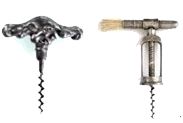 Pinot Envy A new murder mystery from Edward Finstein (aka “the Wine Doctor”). Investigator Woody Robins, amidst the backdrop of the Napa Valley and San Francisco, tries to retrieve a stolen, priceless, large bottle of red Burgundy that once belong to the French emperor, Napoleon Bonaparte. A second book also titled Pinot Envy, written by SW Parra, consists of illustrations of humorous wine related observations with more than 100 clever and comical comments inspired by a wine joke book idea from Sommelier Pablo Sommelier. Both books are available at www.amazon.com. Wine and Teeth An Australian study recently published in Oral Health and Dental Management found that one occasion of drinking wine could affect tooth enamel by lowering the pH of saliva, although the effect is probably limited in the general drinking population. Wine tasters that swirl and hold wine in their mouth before spitting have a greater risk of dental enamel damage. The authors of the study recommended that tasters swig some water or milk after tasting and not brush which can aid enamel erosion. Carbonated soft drinks are probably more problematic than wine. Orange Coast Magazine Wine Dudes Blog Check out my blog posts at www.orangecoast.com. The posts are not confined to Pinot Noir (surprise) and offer a humorous slant to wine. My most recent post on November 5 is a satirical slant aimed at the government warnings on wine consumption. Must-Have Wine of the Week offerings include a number of varietals as well as Pinot Noir.
Why You Like The Wines You Like
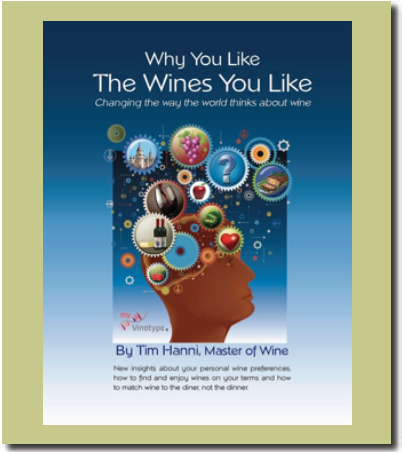 Do you ever wonder why you like a wine and your spouse or friend doesn’t? Are you intimidated when someone raves about a wine that you find only ordinary? Tim Hanni, Master of Wine, tackles the questions in a lengthy (234 pages) soft cover book that intends “to empower wine consumers by providing a new understanding of personal wine preferences and insights into the wine preferences of others.” After nearly twenty years of researching consumer wine preferences, Hanni has identified four distinct groups of people he calls Vinotypes. Finding your Vinotype allows you to discover wines you like and understand why others may have a completely different opinion of the same wine. Feel better already? Your Vinotype is “a set of observable characteristics resulting from the interaction of your genotypic sensory sensitivities in a wine related environment.” A simplified Vinotype sensitivity self assessment is offered in the book (a complete online version is available at www.myVinotype.com). I took the assessment and turned out to be “Sensitive” (the four categories are Sweet, Hypersensitive, Sensitive and Tolerant). The “Sensitive” category fit me to a tee: open to trying new things; satisfied with more delicate wines, yet able to tolerate, if not enjoy, full blown, high intensity wines; and tend to seek out better balanced, less oaky, and less over-the-top wines over time. Armed with your Vinotype i.d., you can understand why you enjoy a certain style of wine and allow you to determine for yourself what good wine is or is not to you. You can become self-assured about your wine preferences as Hanni points out, “Do not be embarrassed or timid in sharing your personal wine preferences whatever they may be!” The book’s paradigms are supported by scientific research and many delusions are debunked. The tongue, for example, is not mapped into four areas - sweet, sour, salty and bitter, but instead, the entire tongue can sense all of these tastes more or less equally. The one hundred point scale (OPHS) popularized by Robert Parker is really a 50-point scale since no wine can score less than 50 points by this method. Wine experts are not somehow specially endowed with super powers or sensory superiority. The book is rather exhaustive and a bit repetitive, but the message is clear and one that any wine lover can understand and embrace. Drink what you like and like what you drink. Available from www.amazon.com for $22.50. |